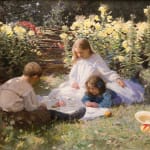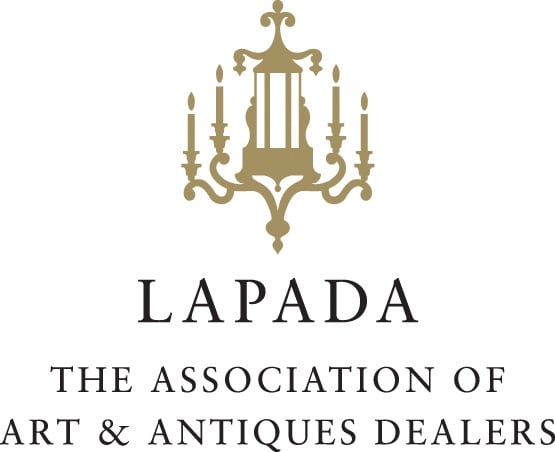-
Artworks
Harry Watson 1871-1936
The Garden Party, c.1913oil on canvasUnframed: 71 x 91.5 cm.; 28 x 36 in.
Framed: 93 x 113 cm.; 36½ x 44½ in.signed lower right 'Harry Watson'WB2848Copyright The ArtistPrimarily known for his landscape studies, The Garden Party is at the pinnacle of Watson’s rare ventures into figurative painting. Garden scenes provided Impressionist artists with ideal settings to develop...Primarily known for his landscape studies, The Garden Party is at the pinnacle of Watson’s rare ventures into figurative painting. Garden scenes provided Impressionist artists with ideal settings to develop their own interpretation of the modern concepts of naturalism and spontaneity, through new techniques using colour and light effects, and a greater sense of dynamism and atmosphere. Watson’s use of a modern, vibrant palette, bold and rapid brushstrokes, and a sense of rapidly capturing a moment in time, rather than a detailed devotion to narrative, sets The Garden Party apart from the depictions of children that his more traditional contemporaries were exhibiting. The painting provides a fascinating link between Edwardian subject matter and the modern techniques that had been developed by the Impressionists, and is redolent of Sargent’s influential Carnation, Lily, Lily, Rose (1885-6, Tate Britain).
The Garden Party delivers a direct experience of light. In this vision of innocent, Edwardian summers, three children sit in a sun-dappled garden, abundant with flowers, and arranged around a pristine white tablecloth. The eldest girl, with luminous hair and resplendent in white lace, rests a protective hand on the younger girl who lies to her side. The boy, positioned with his back towards the viewer, completes this triangular arrangement. The children have their eyes lowered, possibly in prayer as they say ‘Grace’ before their repast, consisting of apples and cake.
Contextually, the painting embodies Edwardian attitudes about the proper cultivation of childhood. In the middle class especially, there was an emphasis on the innocence and gaiety of children, and that should be protected as far as possible from adult life concerns, which inevitably did not fit with working- class notions of childhood, education or with the economic needs of poorer families. However, educationalists like Friedrich Froebel and Maria Montessori, were influential in the idea that children needed time and space to play as much as they needed food and shelter. Concern for children was focused on their health and healthy amusements.The imagery of childhood most available reinforces the notion of an abstract, idealised idea of the child. This illustrated a narrow social band of children, and alternative representations of the working or street child were to be viewed often as part of the presentation of a problem. Rural children could however be portrayed in a similar contextual idyll to the present work as although poor, they were seen to be removed from the grime and dangers of an urban, industrial setting. Within this context, The Garden Party serves both as an aesthetic triumph and a cultural document – revealing of a moment when artistic innovation converged with social aspiration to produce images of enduring resonance and beauty.
Harry Watson studied at the Lambeth School of Art and at the Royal College of Art (1889-94) where he won numerous gold, silver and bronze medals. It was during this time that he would have encountered the work of the Impressionists, exhibited regularly at Durand-Ruel’s gallery on Bond Street, and would have been aware of how it was influencing the works of his contemporaries through exhibitions at the Royal Academy and the New England Arts Club. Initially, Watson painted in a conventional late-Victorian style but later developed into a plein air painter whose works exhibit great freshness and spontaneity, reminiscent of George Clausen and Jules Bastien-Lepage. From 1906, Watson’s Academy exhibits celebrate rural activities, illustrating figures recumbent beside streams, or wandering through woodland settings, using the theme as a metaphor for the profound relationship between nature and mankind.
Provenance
Richard Green, London;
Private Collection, London;
Anonymous sale; Sotheby's, London, 27 November 2003, lot 34;
Richard Green, London;
Private Collection;
Christie’s, London, British Impressionism, 20 November 2018, lot 9, purchased post-sale
by the present owner
Exhibitions
Probably, London, Royal Academy, 1913, no. 230.
Join our mailing list
Be the first to hear about our upcoming exhibitions, events and news
* denotes required fields
We will process the personal data you have supplied to communicate with you in accordance with our Privacy Policy. You can unsubscribe or change your preferences at any time by clicking the link in our emails.




